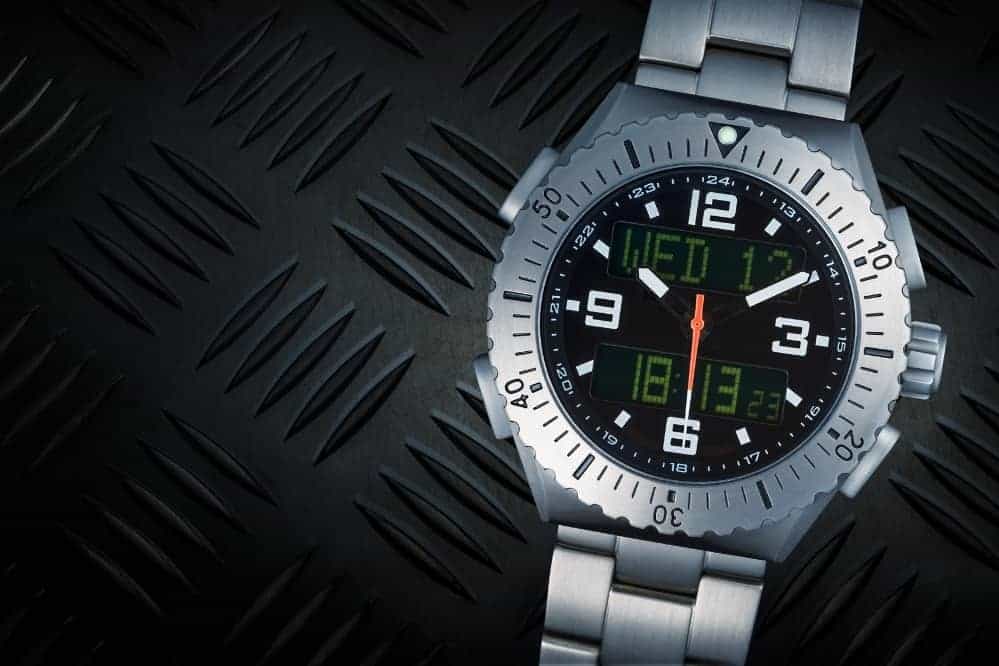Titanium and stainless steel are two of the most popular materials that are used for watches. Both automatic and quartz watches are encased in either a titanium or a stainless steel housing. Modern watches walk a fine line between being fashionable and practical.
Whenever you go to buy a new watch, you will find hundreds of different designs, with a plethora of materials to select from. While the number of choices available to you is definitely a great idea, you have to understand that the selection of materials can be a bit confusing. That is one of the main reasons why you should only take one step at a time when buying a new watch.
In this article, we will talk about two of the most popular materials used nowadays: titanium vs stainless steel watch. Both are different materials that offer their own pros and cons. Titanium watches are incredibly popular right now, primarily among higher-end variants.
They are a much less expensive option than platinum or gold, but the market value of titanium is greater than stainless steel. Stainless steel, on the other hand, is a bit more affordable and can look very similar to platinum. If you want the look and feel of a platinum watch but don’t want to spend a lot of money, you should definitely consider going for stainless steel. Now, let’s compare the differences between the two.
Titanium Versus Stainless Steel: Price
When it comes to pricing and value, they are both generally subjective. It can often be a bit difficult to put a monetary value on specific features. While titanium watches are slightly more expensive, you should know that most people prefer them because they are up to 30% lighter.
Titanium is more expensive to manufacture and as a result, the cost of purchase is also higher. When you compare the price ranges between the two, stainless steel is generally the less expensive option.
Titanium Versus Stainless Steel: Strength
Strength and durability are tightly linked together. Titanium, despite being a more expensive choice, is slightly more limited when it comes to scratch resistance and durability. If you have used a titanium watch before, you should know that they are much more prone to scratches.
Another thing that you should know is that the scratches are slightly more noticeable on a titanium watch when compared to a stainless steel variant. The reason for this has to do with the reaction caused by titanium when it is exposed to oxygen.
This creates a layer of oxide on the surface that ultimately offers greater protection to the watch. This layer of oxide is slightly more visible, and this is one of the main reasons why the scratches are so visible.
However, while they are more prone to scratches, you should know that buffing them out is also much easier. For instance, you can easily buy a refinishing pad for your titanium watch, which will allow you to remove the thin layer of oxide that forms around the scratch.
On the other hand, you can also repolish and brush a stainless steel watch, but you should know it takes slightly longer to do that. There is also the risk of shaving away a greater amount of metal in the process. If you continue polishing the stainless steel case over a longer period of time, you will notice that the shape of the case will begin to change entirely.
To summarize, titanium watches scratch easily and are also easy to repair. Stainless steel watches don’t scratch that easily, but they are also much more difficult to get out.
Titanium Versus Stainless Steel: Weight
As mentioned above, titanium is lighter and more comfortable than stainless steel watches. They are up to 30% lighter, which makes a huge difference for people who wear their watches throughout the course of the day.
However, if you like to put a heavy watch on your wrist, you will want to invest in a stainless steel watch. Titanium is so light that you will virtually forget that you have a watch on!
Titanium Versus Stainless Steel: Allergy
People with sensitive skin often report rashes or excessive itching where the band is tied. This is primarily caused due to the presence of nickel that is commonly used in certain stainless steel watches.
The grade and blend of metal used for stainless steel watches plays an important role. Common grades include 906L, 316L, and 204L. Each of these offer different advantages, and the metal composition differs as well.
There are certain less expensive grades of stainless steel used in watches that are not branded, and they are generally likely to cause more skin irritation. These are less expensive brands designed to cut costs and provide something that just “looks good.”
Obviously, you may want to steer clear of those.
On the other hand, titanium is unlikely to cause such a reaction. As mentioned, the oxide coating that develops around the titanium makes it virtually hypoallergenic. Basically, your skin never touches the titanium band; it only comes in contact with the oxide coating.
As a result of that, there is no reason to worry about allergies. If you feel that your skin is sensitive to certain watches, you should consider opting for a titanium watch instead.
Titanium Versus Stainless Steel: Scratch Resistance
This one is also fairly obvious: titanium is not as resistant to scratches when compared with stainless steel. Stainless steel is capable of resisting more scratches, but once you get a scratch on it, it’s going to be much harder for you to get it out.
On the other hand, removing the scratches from the oxide coating of the titanium is considerably easier. A simple refinishing pad will do the trick.
Conclusion
Both have their pros and cons, with the most obvious one being the fact that titanium watches are a bit more expensive than their stainless steel counterparts, so it’s up to you to decide which one you want.
